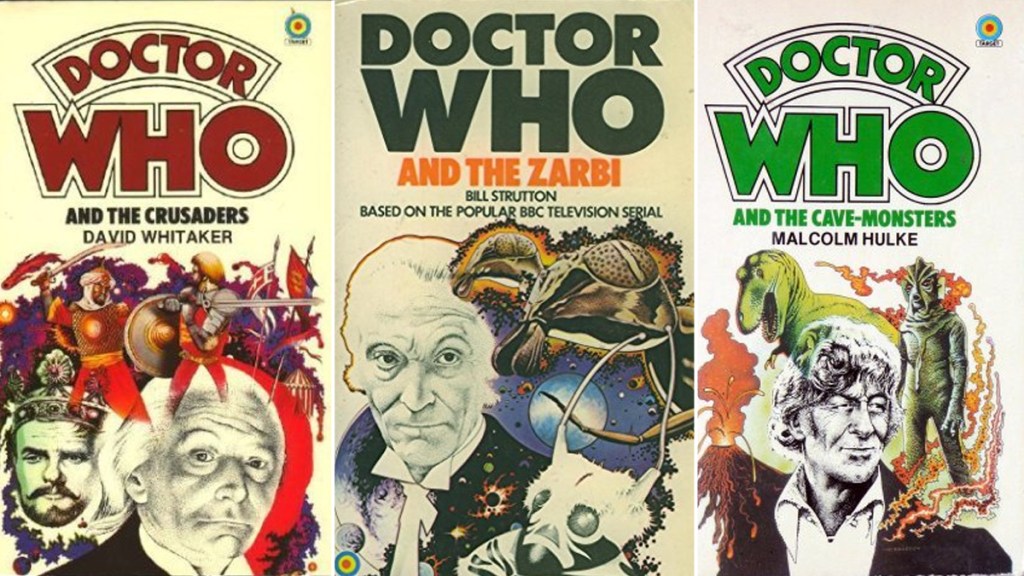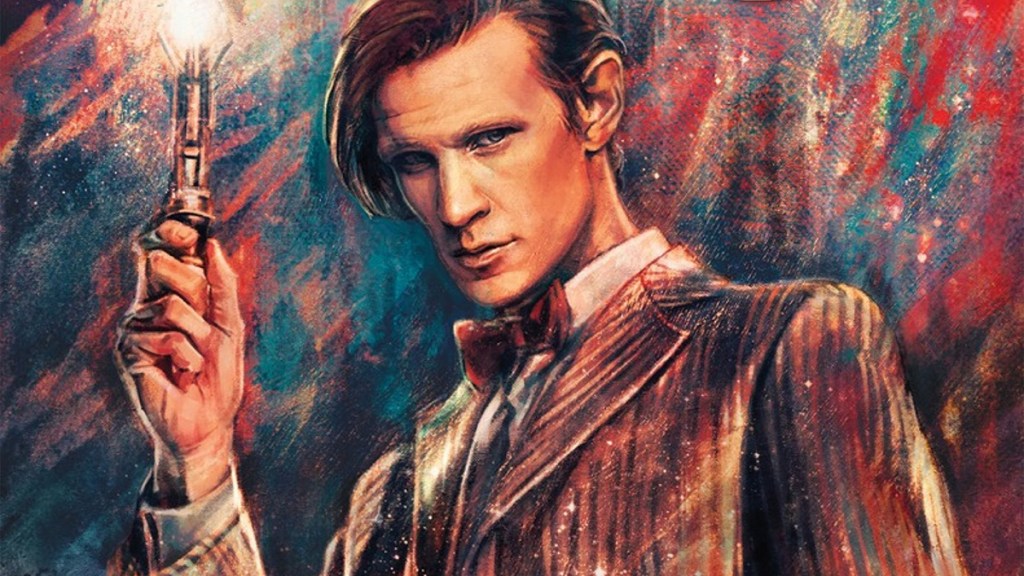What Next for Doctor Who Books?
A new edition of the first Doctor Who novel ever published brings the tie-in books full circle, so what’s their future?

BBC Books has released a new edition of ‘Doctor Who and the Daleks’, David Whitaker’s adaptation of the first Dalek story that was originally published in 1964 (under the title ‘Doctor Who in an Exciting Adventure with the Daleks’) and the first Doctor Who novel ever published. The difference with this re-release (there was an earlier one in 2011) is it’s in hardback with illustrations by American artist Robert Hack (who started working on the IDW Comic range in 2008). You may have seen his art in the comics and TV title sequence of The Chilling Adventures of Sabrina.
Hack’s approach to the art, which is the really distinctive element here, is a successful fusion of the monochrome TV original, Whitaker’s prose, and the Peter Cushing colourful movie version from 1965. There are some of the same bold colours from Cushing’s movie but usually one colour dominates each painting, giving the images a sense of monochrome without painting in only greys. With Whitaker’s imagination not limited by a TV budget Hack is also able to work on a larger scale than the original, and ramp up the horror in some scenes: the realisation of the Dalek mutants is satisfyingly unsettling. Whitaker’s revisions are intriguing too, treating the book as if it were an entry point into the series for the reader and so coming up with a new way for the characters to meet (as well as coming up with an idea for a Dalek that would ultimately be realised in the TV show over 20 years later). Plenty of the story is as you remember it, though, albeit told from the viewpoint of Ian Chesterton.
The novel was originally commissioned by Frederick Mueller Ltd. and released to coincide with the Daleks’ second TV appearance – ‘The Dalek Invasion of Earth’. This meant a turnaround of nine months (with Whitaker initially contacted in February and the book being published in November). Seizing on the rising Dalekmania of the time, the book sold well and was reprinted twice. Further titles were commissioned, with Bill Strutton novelising ‘The Web Planet’ as ‘Doctor Who and the Zarbi’ and Whitaker adapting ‘The Crusade’ as ‘Doctor Who and the Crusaders’ (in 1965 and 1966). These did not sell as well, quite possibly due to the lack of Dalek involvement, and no more stories were adapted.
Target: Teaching a Generation to Love Reading
While these books were reprinted a few times, the next big development came in 1972 when Target Books was formed as a children’s imprint of Universal-Tandem. An editor, scouring existing publishers for material to option, discovered the three Doctor Who adaptations and decided to get the rights to publish them in paperback before contacting the production team at the BBC. Barry Letts and Terrance Dicks were positive about the idea, with Dicks offering to write adaptations. The initial reprints sold very well, and were released again with adaptations of ‘Spearhead from Space’ (‘Doctor Who and the Auton Invasion’ by Terrance Dicks) and ‘Doctor Who and the Silurians’ (‘Doctor Who and the Cave Monsters’ by Malcolm Hulke). Now adapting stories featuring current Doctor Jon Pertwee, the range was off to a very solid start.
Written with an economical prose style, the Target Doctor Who books are widely credited with teaching a generation of fans to read. In the Seventies there were non-fiction tie-in books and fiction aimed at younger readers. In the Eighties, though, the audience for the books was shifting to older and more committed fans. Target also tried launching ranges to counter the inevitable point when they would have adapted all the television stories it was possible to adapt (a few weren’t novelised, some because Target couldn’t afford Douglas Adams’ fee and some because Terry Nation and Eric Saward couldn’t agree a deal over Saward’s two Dalek stories). They tried spin-offs involving companions Turlough and Harry Sullivan, and adapting stories from the cancelled version of Season 23. As the number of new TV stories reduced, the range finally finished in 1990 with an adaptation of 1969’s ‘The Space Pirates’ (incongruously released with the McCoy era logo). For potential (extremely niche) pub quiz use: the last book actually released in the Target range was a reissue of ‘Talons of Weng-Chieng’ in 1994.

These books, even at their most economical, often altered or expanded upon what we saw on screen. As more writers got the chance to adapt their own work in the Eighties, some took the opportunity to base the novels on different drafts or take advantage of the medium: Donald Cotton’s adaptation of ‘The Romans’, for example, took the form of letters collected by Tacitus. The adaptations of the Seventh Doctor’s stories were notable in this regard, adding a lot to the televised versions (for example, a chapter from the point of view of the Special Weapons Dalek, the Doctor as Merlin, or an epilogue featuring an older Ace after she leaves the TARDIS).
New (and Missing) Adventures
The New Adventures line came about after Virgin took over WH Allen, then-owners of the Target Imprint, at a point when the line was still profitable (sales were consistent and predictable) and the number of stories left to adapt was in the single figures. TV Producer John Nathan-Turner had been resistant to original novels while there were still stories to adapt, but soon there would be none. As more recent novels had started getting longer and more expansive, the new line of books developed from there featuring the Seventh Doctor and various companions. After a few years they were joined by the ‘Missing Adventures’ range that featured past Doctors and companions. These were a mix of homage and attempts to replicate the tone of the show across different eras, but also took advantage of the expanded palette of the New Adventures books.
Retrospectively, the New Adventures were a mixed bag from book to book, but at their best they expanded what Doctor Who was capable of, not just in terms of concepts and scale but emotionally. For every gratuitous instance of sex and swearing there’d be something new that cast fresh light on the show and its main character (with Paul Cornell emerging as the range’s most acclaimed author in this respect, later adapting his novel ‘Human Nature’ for TV, and with Russell T. Davies taking aspects of his book ‘Damaged Goods’ into the 2005 series).
BBC Books: Inspiring the TV Revival
In 1996, BBC Books, then part of BBC Worldwide, got the rights to publish Gary Russell’s novelisation of the TV Movie. Virgin’s licence for Doctor Who books was not renewed. The main line of new Doctor Who fiction became The Eighth Doctor Adventures and the Missing Adventures became The Past Doctor Adventures. The new lines were initially intended to be less graphic, more suitable for a family audience, but beyond that the range lacked direction. It cohered somewhat when Stephen Cole took over as editor, and then – hilariously in hindsight – Cole left in 2000 after writing a book in which Gallifrey – alongside a lot of unresolved plot strands – was destroyed in order to provide a clean slate for Justin Richards to take over the line, only for Russell T. Davies to do the same thing for himself five years later.

The BBC Books lines initially sold well, and featured several creative high points and ideas that would appear in the TV series post-2005, but its sales eventually dwindled to the point where critically acclaimed titles such as Simon Guerrier’s ‘The Time Travellers’ would fail to make their advance back. These lines finished in 2005 after the TV show returned, with the BBC New Series Adventures taking their place (and BBC Books being sold to Random House in 2006). These were paperback-sized hardbacks featuring the current Doctor, with the 9 releases in 2006 selling 321,230 copies. These releases continued in batches of three until 2012, while standalone titles began in 2010 (with Michael Moorcock, Dan Abnett and Jenny Colgan writing Eleventh Doctor stories).
Meanwhile, past Doctor stories returned. In 2011 Gareth Roberts novelised ‘Shada’, Douglas Adams’ Season 17 story that was never finished due to industrial action. It had been one of the novels Target had been unable to publish from the original run (all of which have now been adapted). New editions of Target novels began to be reprinted and Stephen Baxter began a yearly run of past Doctor novels by prestigious writers (with ‘The Wheel of Ice’ featuring the Second Doctor, Jamie and Zoe, followed by Alastair Reynolds’ Third Doctor novel and A.L. Kennedy’s Fourth Doctor novel over the next two years). Meanwhile two series of novellas were published, one by Puffin for the anniversary year of 2013 and then the Time Trips range in 2014.
New Series Adventures and the 60th Anniversary
When the New Series Adventures returned in 2013 it was with only one batch of three books, while the ongoing original audio stories ceased after AudioGo folded (with Random House rebranding the imprint as BBC Audio and releasing audiobooks of the Twelfth Doctor novels in 2015). The Twelfth Doctor had one set of books released per year, and then three Thirteenth Doctor novels were released in 2018. This was the last set of New Series Adventures published, with three titles released through BBC Children’s Books between 2018 and 2021 (two by David Solomons and one by Jacqueline Rayner). The same publisher also released two ‘Team TARDIS Diaries’ in 2021, with the second half of the series currently unreleased. ‘At Childhood’s End’ is a standalone novel written by Sophie Aldred (the actor who played Ace) and published in 2020. After Ace’s appearance in 2022’s ‘The Power of the Doctor’ it’s not entirely clear whether that novel is consistent with the TV canon, but to be honest, that’s never stopped anyone before.
There’s a definite sense of the book ranges gaining and then losing inertia. So where can Doctor Who books go from here? Something must be planned for the 60th anniversary year, and at the very least a new line of tie-in novels will be considered for David Tennant and/or Ncuti Gatwa’s Doctors. We don’t know what scale any releases would be on, and what age groups they’d be aimed at. The recent books have aimed younger, and there’s no obvious reason not to pursue that age group while also bringing out titles aimed at the whole family. We’d be surprised if there wasn’t more tie-in fiction in Doctor Who’s future, so what would you like to see?
Doctor Who and the Daleks is available to buy now.
